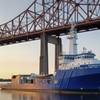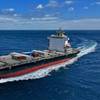SNA Concludes Annual Symposium
The Surface Navy Association (SNA) concluded its 29th annual three-day symposium in Arlington, Virginia, Jan. 12.
The symposium focused on distributed lethality to enable sea control and facilitated professional discussions between military members, industry representatives and lawmakers regarding surface warfare technology, tactics, training and career development.
The first day commenced with welcomes, roundtable discussions and keynote addresses by Navy leaders, including Vice Chief of Naval Operations Adm. William Moran and Master Chief Petty Officer of the Navy Steven Giordano.
Vice Adm. Thomas Rowden, commander, Naval Surface Forces/Naval Surface Force, U.S. Pacific Fleet, detailed his new Naval Surface Force Strategy and related it to the symposium's objectives.
"It's all about deterring conflict, and that's what the strategy lays down," Rowden said. "The idea behind distributed lethality is to make all of our forces more lethal so any potential adversary not only has to worry about the aircraft carrier, but has to worry about all those submarines and all those surface ships, and the potential threat of those surface ships. Sea control is a foundational thing that enables everything we do in the United States Navy."
Secretary of the Navy Ray Mabus, in what was likely his final official address in office, spoke at the symposium on the second day. Mabus focused on the Navy's accomplishments during his tenure and encouraged the audience to continue acting on distributed lethality and sea control, the overarching symposium themes.
"Distributed lethality makes the job of potential adversaries much more difficult," Mabus said. "We've got to be forward; we've got to be out there."
Wednesday continued with a Coast Guard update, followed by a discussion panel on the takeaways from last year's 3rd Fleet Pacific Surface Action Group operations and current and future logistics in the mine warfare community. Marine Corps Maj. Gen. Christopher Owens, director, Expeditionary Warfare, also elaborated on ongoing efforts to leverage unmanned technology to decrease risk to Sailors from mines.
"We are moving to using unmanned systems that have the capability to not only go off board ships, but over the horizon into minefields," Owens said.
Members of the British, Canadian, Norwegian and Danish navies met for a luncheon to discuss the importance of interoperability between the U.S. and its allies, highlighting aspects of their respective navies as key to future cooperation.
The symposium concluded Thursday with an awards luncheon and shipbuilding and maintenance panels, which explored the risks and benefits to introducing new technology into shipyards.
"There is stability across all platforms, and we have some design changes, and the level of quality is good," said Rear Adm. William Galinis, Program Executive Officer, Ships, the office responsible for Navy shipbuilding. "We have a high level of quality in all of our shipyards, and we are pleased with where we are in progressing-going to 355 ships. From a shipbuilding perspective, the capacity is there."
Vice Adm. Barry McCullough (Ret.), the president of SNA, offered closing remarks at the conclusion of the symposium, thanking participants and encouraging input for future symposiums.
"We really value your participation, your ideas, and your questions, and we invite you to continue your part with us in the future," McCullough said.












